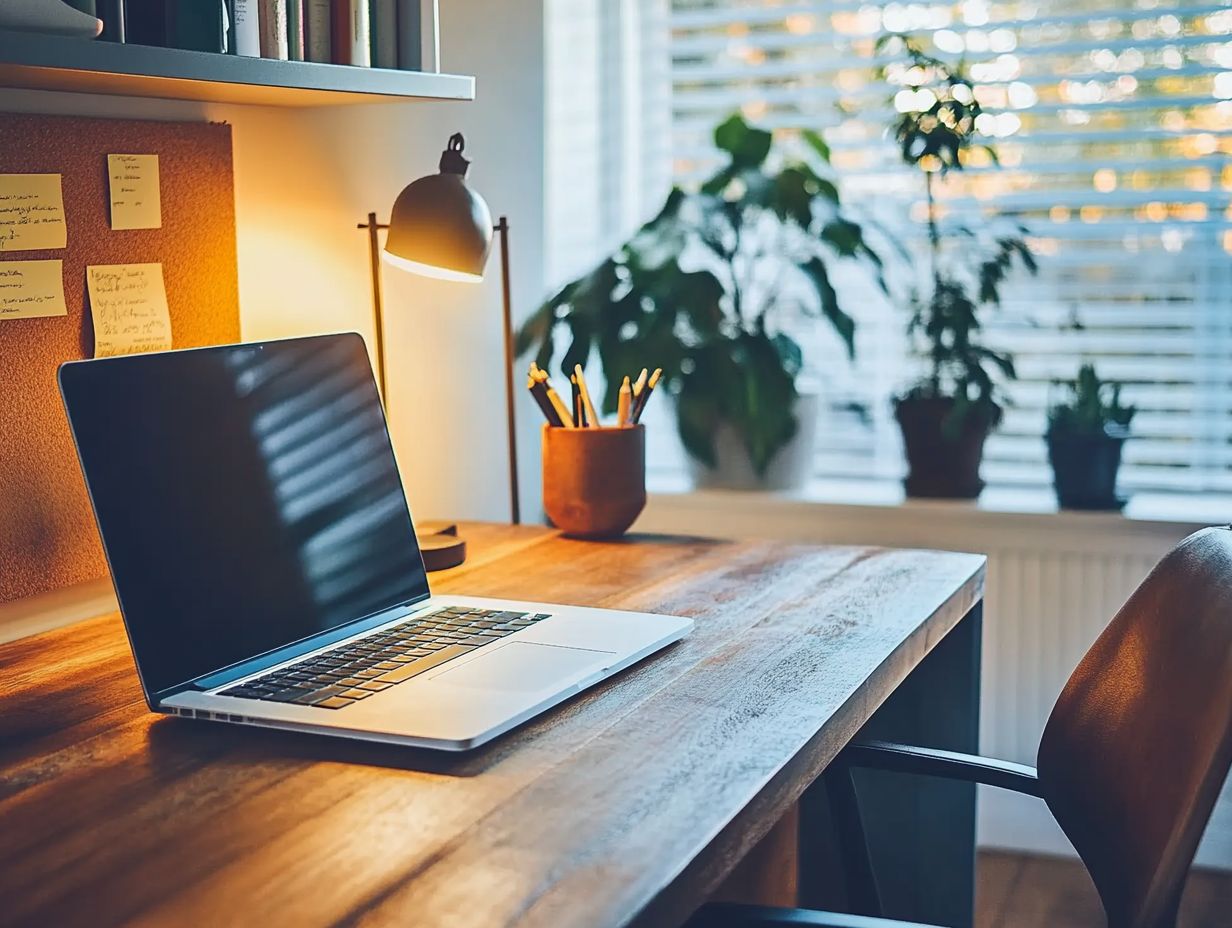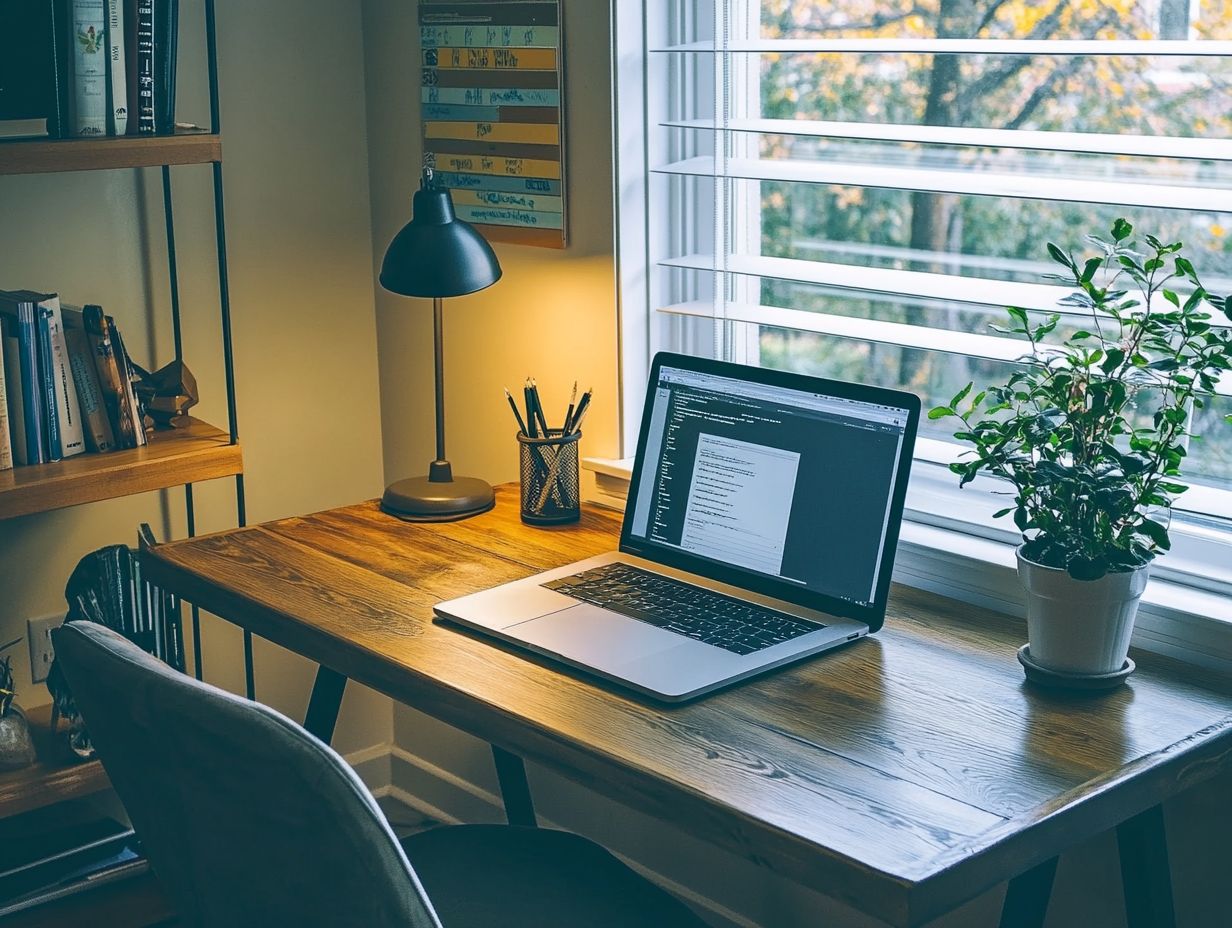Establishing a productive home office is essential in today’s work-from-home environment. Your workspace should not only reflect your personal style but also enhance comfort and efficiency. This article examines key factors in creating an ideal home office, including the selection of ergonomic furniture and essential technology, as well as strategies for maximizing natural light and airflow. Additionally, it provides organizing strategies, tips for setting the appropriate atmosphere, and methods to maintain a healthy work-life balance. By implementing these recommendations, one can transform their workspace into a hub of creativity and productivity.
Key Takeaways:
Creating an Ideal Home Office Space

Establishing an optimal home office requires meticulous planning and thoughtful consideration of various design tips and elements that contribute to a productive work environment.
Factors such as ergonomic workspace design, efficient storage solutions, and an organized work area play critical roles in enhancing the work-from-home experience. According to ResearchGate, ergonomic workspace design can significantly reduce the risk of musculoskeletal disorders, underscoring the importance of incorporating such elements into your home office.
It is essential to incorporate features that promote creativity and focus while also facilitating effective clutter management.
By customizing the layout of the workspace to align with personal preferences, individuals can create a harmonious and inspiring environment that enhances productivity and minimizes distractions.
Factors to Consider
When designing a home office, it is imperative to consider several factors that contribute to an effective and inspiring workspace, including clutter management and the incorporation of natural light.
Selecting appropriate office furniture is essential; it should not only align with your aesthetic preferences but also facilitate your work activities. Features such as privacy screens can effectively minimize distractions, allowing for enhanced focus in a work-from-home environment.
Natural light is vital in elevating mood and boosting productivity; therefore, positioning your desk near windows can significantly improve your overall work experience. This aligns with insights from Harvard Business Review, which calls natural light the number one office perk. Additionally, opting for ergonomic chairs and desks promotes comfort during extended hours of work.
To maintain organization, it is advisable to establish a systematic approach to clutter management by utilizing storage solutions such as shelves and file cabinets, which aid in sustaining an orderly workspace. Furthermore, incorporating personal elements such as plants or artwork can stimulate creativity while ensuring that the environment feels both inviting and energizing.
Choosing the Right Furniture and Equipment
Selecting appropriate office furniture and equipment is crucial for creating an ergonomic workspace that fosters comfort and productivity while working from home.
Investing in high-quality office furniture, such as a comfortable ergonomic chair by Herman Miller and a functional desk setup, establishes a solid foundation for a healthy work environment.
Furthermore, incorporating essential technology and tools, such as a Studio Display by Apple, into the workspace can significantly improve workflow and overall job satisfaction.
Thoughtfully chosen furniture not only supports physical well-being but also contributes to a more organized and efficient work atmosphere.
Ergonomic Options for Comfort and Productivity

To enhance comfort and productivity in a home office, it is essential to explore ergonomic options. An ergonomic workspace can significantly reduce discomfort and strain during extended working hours, resulting in a more enjoyable work-from-home experience. Key components that contribute to an optimized workspace include comfortable seating, adjustable desk setups, and proper alignment of the computer screen.
By investing in ergonomic furniture and tools, individuals can establish a work environment that promotes productivity and health.
Numerous ergonomic products are available in the market, designed to meet various needs and preferences. Brands such as Herman Miller and Steelcase offer chairs that provide support for the lumbar region, while desks from Varidesk feature adjustable heights to encourage movement and minimize fatigue. According to a recent publication on LinkedIn, incorporating ergonomic solutions can notably enhance workplace productivity and wellbeing.
Additionally, incorporating accessories like keyboard trays and monitor risers can further improve posture, fostering a well-aligned workstation.
Ultimately, selecting the appropriate combination of furniture enables individuals to create a personalized setup that enhances focus, reduces discomfort, and significantly improves daily work performance.
Essential Technology for a Functional Workspace
In a functional workspace, the integration of essential technology is pivotal for maintaining efficiency and focus during work-from-home hours. This includes investing in high-quality task lighting to minimize eye strain and enhancing air quality through the use of indoor plants, which also contribute aesthetic value to the workspace layout.
Ensuring that technology is optimized for specific tasks can significantly enhance productivity and overall job satisfaction in a home office environment.
The incorporation of computer peripherals, such as ergonomic keyboards and precision mice by Shawn Blanc, can greatly improve user comfort, thereby helping to prevent repetitive strain injuries.
Furthermore, smart lighting solutions that adjust according to the time of day can create an inviting atmosphere conducive to concentration. Air purifiers also play a crucial role in maintaining a healthy workspace by filtering out pollutants, ensuring a breath of fresh air during extended working hours.
A thoughtfully organized layout, supported by these technological tools, not only maximizes available space but also fosters a harmonious environment that aligns with individual work styles, possibly incorporating soothing colors and Feng Shui principles.
Maximizing Natural Light and Airflow
Maximizing natural light and airflow is crucial for establishing a vibrant and invigorating home office environment that fosters well-being and productivity.
Natural light not only enhances mood but also decreases reliance on artificial lighting, thereby improving the energy efficiency of the workspace. The integration of biophilic design elements, such as expansive windows and indoor plants, further promotes clean air circulation and a fresher atmosphere.
By achieving a balance between natural light and airflow, one can create an organized workspace that encourages creativity and focus.
Benefits of Natural Light and Airflow

The advantages of natural light and airflow in a home office extend beyond mere aesthetics; they play a crucial role in enhancing productivity and overall well-being. Research has demonstrated that natural light can elevate mood, reduce eye strain, and improve focus, while clean air is essential for maintaining energy levels and supporting cognitive function.
A thoughtfully designed workspace that maximizes exposure to natural light can incorporate calming colors and foster a soothing atmosphere, ultimately promoting creativity and efficient work habits.
Studies indicate that individuals working in environments with sufficient natural light experience a 51% reduction in drowsiness, along with a significant increase in workplace satisfaction. When combined with fresh air, these benefits are further amplified, resulting in enhanced concentration levels and reduced stress.
To optimize these elements, it is advisable to:
- Position the desk near a window
- Utilize light-colored furniture to reflect sunlight effectively
- Incorporate plants into the workspace to purify the air and enhance the overall ambiance
Additionally, regularly opening windows can introduce refreshing breezes, further invigorating the environment and positively impacting both physical and mental health, which can be complemented by the use of essential oils like Rosemary and Lavender.
Organizing Your Home Office
Effectively organizing a home office can have a substantial impact on productivity and the overall work experience. Implementing strategies for clutter management is essential to maintaining an organized workspace that minimizes distractions and enhances focus.
By utilizing innovative storage solutions and optimizing the workspace layout, individuals can create a clean and efficient work environment where all essential items are readily accessible. This fosters a sense of calm and order, ultimately contributing to success.
Strategies for Clutter-Free and Efficient Workspaces
To achieve a clutter-free and efficient workspace, it is essential to implement effective strategies for clutter management. This may involve utilizing storage solutions such as organizers, shelves, and desk accessories that facilitate an orderly work environment.
Additionally, establishing a routine for decluttering and maintaining the workspace will help minimize distractions, ensuring that the home office remains a source of inspiration and productivity.
Regular assessment of both physical and digital clutter is also important. For example, dedicating time each week to tidy your desk can lead to significant improvements.
In the realm of digital organization, archiving outdated files and categorizing documents into clearly labeled folders can help mitigate feelings of overwhelm. Utilizing cloud storage solutions not only conserves physical space but also enhances accessibility to important documents.
Employing techniques such as the ‘one-in, one-out’ rule can effectively prevent the accumulation of new items that may contribute to clutter. By adopting these strategies, one can cultivate a more organized, productive workspace that is sustainable and conducive to an enjoyable working environment. Integrating elements of Feng Shui can also enhance the flow and feel of your workspace.
Setting the Right Atmosphere for Focus

Establishing an appropriate atmosphere for focus in a home office is essential for enhancing productivity and improving the overall work experience. Drawing workspace inspiration from brands like Herman Miller and Grovemade can elevate your home office setup.
The incorporation of soothing colors in workspace design contributes to a calming environment that encourages concentration and creativity. Furthermore, the use of essential oils can promote relaxation and alleviate stress levels, thereby enhancing one’s ability to concentrate.
When coupled with comfortable seating arrangements and minimal distractions, these elements collectively cultivate an inspiring workspace that is conducive to productivity.
Using Colors, Scents, and Sounds for Productivity
Strategically utilizing colors, scents, and sounds in a home office can significantly enhance productivity and create an optimal working environment. Incorporating pieces like a Studio Display from Apple or design elements from Minted can add a modern touch.
Soothing colors such as soft blues and greens establish a tranquil atmosphere conducive to focus. Meanwhile, essential oils like rosemary and lavender can invigorate the mind or promote a sense of calm.
Additionally, incorporating task lighting that complements the overall ambiance can reduce distractions and provide adequate illumination for the workspace, ultimately fostering an environment that inspires creativity.
To further enhance this effect, consider incorporating warm accent colors such as yellow or orange in moderation; these hues can stimulate creativity and elevate mood without overwhelming the senses.
Moreover, a soundscape featuring nature sounds, such as gentle rain or rustling leaves, can contribute to concentration by masking distracting noises and facilitating deep work. Consider air purifiers like the Airmega or plants such as English Ivy and aloe vera to enhance air quality.
When integrating these sensory elements into your space, it is advisable to experiment with various combinations to determine what works best for you. For instance, one might try a citrus-infused diffuser paired with soft instrumental music.
This personalized approach can create a tailored environment that not only enhances productivity but also supports overall well-being.
Maintaining a Healthy Work-Life Balance
Maintaining a healthy work-life balance is essential for individuals working from home, as it ensures that personal and professional responsibilities do not interfere with one another. A strategic separation of work and personal life can be accomplished through effective physical space management, which includes creating distinct areas within the home office layout.
An organized workspace that minimizes distractions is crucial for achieving this separation, enabling individuals to concentrate on work-related tasks while effectively delineating personal time.
Tips for Separating Work and Personal Life in a Home Office with Shawn Blanc’s Insights
To effectively separate work and personal life in a home office, it is essential to implement practical strategies that facilitate a healthy work-life balance. Establishing an organized workspace that distinctly defines the work area can significantly minimize distractions and provide a sense of structure.
Additionally, investing in comfortable office furniture designed for prolonged use can enhance both productivity and relaxation during personal time, thereby supporting overall well-being.
Creating a designated area for work, separate from personal space, is crucial in cultivating this balance. For instance, utilizing room dividers, such as those from Versare, or selecting a dedicated desk can establish both visual and physical boundaries.
Incorporating functional storage solutions, such as shelves and filing cabinets, ensures that the workspace remains clutter-free, which in turn reduces stress and enhances focus.
Furthermore, establishing a routine that signals the beginning and end of the workday is important for facilitating mental disengagement. These techniques not only improve efficiency but also serve as cues to transition from work mode to personal relaxation.



